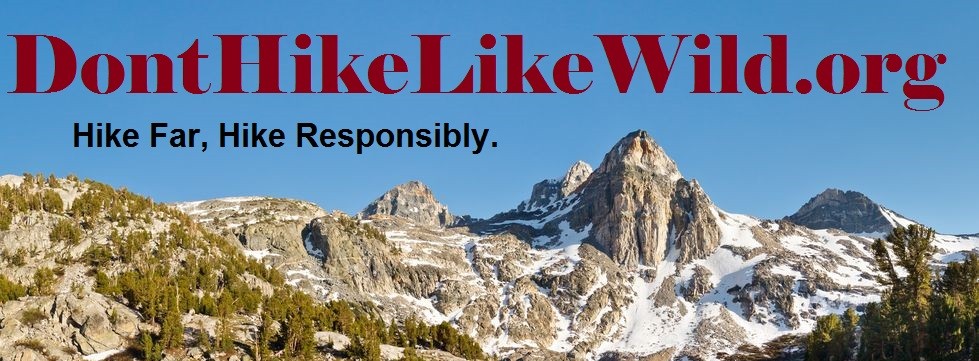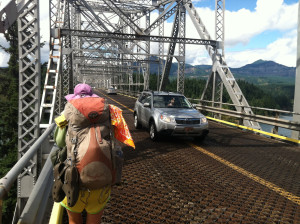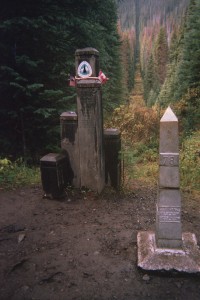At the end of her book WILD, Cheryl Strayed stands at the foot of the Bridge of the Gods on the Columbia River, which forms the dramatic border between Oregon and Washington. But instead of continuing her hike northward to the terminus of the Pacific Crest Trail in Canada, she chose to end her journey here, and begin the rest of her life.
At this point in the story readers of WILD are treated to more reflections from her months of hiking across deserts, forests and mountains.
I was thrilled by the prospect of reaching Cascade Locks and also saddened by it. I didn’t know how living outdoors and sleeping on the ground each night and walking alone through the wilderness all day had come to feel like my normal life, but it had. It was the idea of not doing it that scared me.
Other platitudes were a little more existential.
I had arrived. I had done it. It seemed like such a small thing and such a tremendous thing at once, like a secret I’d always tell myself, though I didn’t know the meaning of just yet.
However stirring these reflections, Strayed seems to have left her readers in limbo by ignoring perhaps the most important aspect of finishing a big trip like hiking the PCT – the task of returning to the everyday world. While every long-distance hiker gushes with pride at accomplishing such an impressive feat as hiking across a nation, many are left with little plan for what happens next.
The truth is that many thru-hikers don’t take much time to savor the moment. They are often quite haggard and beat-down after months of walking 25 miles a day, and they can’t wait to get home to familiar faces of friends and family, a home cooked meal, a hot shower and their own bed. Some are in a rush to return due the fact they have been hiking on a deadline to get back to work or school or some other commitment. These are perhaps they lucky ones.
Other hikers have no real plan for what to do after they are done with the trail. Often the thru-hike represented such a huge undertaking that they never really put much thought into what happens next. Or if they did, they find that their experience on the trail has affected their outlook on life to the point that they may never be able to return to their previous way of living.
Clearly it is important for thru-hikers to have some sort of exit plan for when they are done with a major hike. Of course this plan can change, but having that foundation can be important.
Many hikers experience financial difficulties after finishing the trail. Strayed writes of having 20 cents to her name when she finished the trail. Often the lure of adventure has led people into debt, which they now must reconcile. While it might be a good idea to have job lined up upon return from the trail for financial reasons, it is also important to just have something to occupy one’s time. Even a volunteer position such as working on a farm, can give the hiker a sense of purpose and can serve as transition to the next phase of life. Seasonal work at places like ski resorts or serving the holiday needs like retail or shipping can serve these purposes nicely.
Some hikers have learned that it is worth the financial sacrifice to maintain their home by paying rent over the summer, so that they may have a place to land. Otherwise, a hiker who is now well-practiced at being homeless, might choose to maintain that status by default, whether that means sleeping under bridges or couch surfing with friends. This usually works until the long summer days quickly transform into long winter nights. At that point many hikers have found themselves homeless longer than they expected with no real plan for re-entry.
Other hikers, once they are done with the trail, can only really focus on their next big thru-hike. While this can lead to a successful life-long passion for hiking, hikers should take care to make this choice with a mind toward sustainability. That includes not only the financial practicalities, but also the social impacts.
So often friends and families, while curious and interested in the stories from the trail, have no clue what it is really like to live while carrying everything one needs on your back. The values such as simplicity and appreciation of beauty that hikers come to cherish stand in contrast to the values of the fast-paced, gas-guzzling consumer culture that we find ourselves returning to. The challenge is to find a way to merge these worlds without losing our sense of purpose.
So as Cheryl Strayed certainly felt a great sense of accomplishment and transformation once her hike was done, she also does a disservice to her audience by not explaining how she was able to use these lessons as she returned to the ‘real world’. We know that she soon met her future husband, got married, raised a family and eventually became a bestselling writer. But how she made that leap form a dirty and haggard hiker to a contributing member of society is perhaps the most important untold part of her story.
These transitions are never easy. Hikers can benefit by considering that however amazing and transformative their experience on the trail has been, there is a potentially an even more gratifying future after their hike.
For more perspective on re-entry, look for the upcoming film Lost or Found, produced by “Just Andy” Davidhazy, the guy who did the time lapse selfies for the entire PCT.


